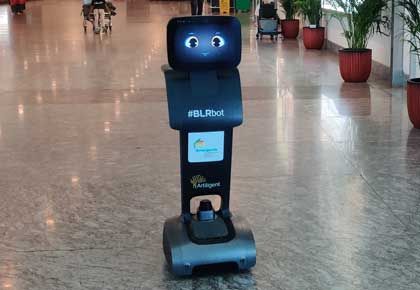‘This is a race where every technology can be used by the bad guys and good guys.’
Artificial Intelligence has become the buzzword, as technology adoption increases in both enterprises and the government space.
Sriram Raghavan, vice-president, IBM Research AI, has overall responsibility for AI research across all IBM research labs.
“There is massive opportunity — especially in areas like health care, education and skilling, citizen services,” Raghavan tells Shivani Shinde/Business Standard.
The state of AI both globally and in India?
There has definitely been an inflection in the growth of AI.
Per the latest IBM study, AI adoption on average is now in the 35-42 per cent range across geographies and sectors.
AI has certainly moved away from experiments to adoption.
Among the most common entry points for AI adoption and the biggest use-case has been transforming customer services.
The reason is that mapping customer services to business value is easiest, as it directly hits customer support, care, and feedback.
A second category where we see a lot of opportunity is IT automation.
That’s also the reason why we have created an organic plus inorganic investment strategy over the last three years.
It began with work around Watson AIops that came out of IBM Research, including contributions from a lab here in India, coupled with our acquisitions of Instana and Turbonomic, and it gives us a package of increasing AI in IT automation.
A third area where we are starting to see more traction is the use of AI in industrial and manufacturing.
Covid brought AI to the fore in both customer services and the industrial sector.
Industry has been digitising for a long time and has reached a point where AI in industry for 4.0 is starting to grow more and more.
Anomaly detection and prediction are rich use-cases in the industrial sector.
Another emerging area, which will happen more and more, is actual business process automation.
There is a huge opportunity for automation, and that is what we are looking to tap with products like Watson Orchestrate, that again came out of IBM Research.
There is a dark side to AI too, such as chatbots or AI being used to create fake accounts, or for cybersecurity threats. How does one deal with this?
There are problems that consumer-facing companies face in deploying AI.
It does not challenge IBM, given our focus on enterprise. However, when we deploy AI systems for B2C companies, a big portion of the work we do is robustness testing.
What is the data on which we build those AI systems?
The governance of the AI that we deploy for our clients is a big element of the security we bring to the table.
The second element is AI in security, where we are completely committed.
We know AI is going to be used as a weapon by the bad guys.
Our only answer is that we have to use AI even better.
That’s why AI is embedded in every layer of our security offerings.
This is a race where every technology can be used by the bad guys and good guys.
Our mission is to help our clients and we do this with whitehat hacking, which is where our acquisition of Randori kicks in.
It essentially behaves like a bad guy, tests your system and tells you all the things you have to fix.
That is AI at work to help you make your system more robust.
But there is a bigger question when you talk about the principles of AI, and we think responsible AI has three elements — ethics, trustworthy AI and governance of AI.
Are AI, blockchain, and quantum computing interlinked, or three different tech directions?
Interlinked. We have a roadmap for all three technologies, but the biggest innovations happen when they connect.
We have projects where AI is being done on data and the blockchain.
AI for example, is a critical element of how quantum error correction is done.
That’s how AI is an instrument in enabling quantum.
We also see a future in which AI and quantum will come together.
All this requires foundational science and hence it’s still in the labs.
At IBM Research we have this vision where bits, neurons and qubits come together.
The other way to think is, bits was about information meeting mathematics, neurons was about information meeting biology, and quantum is about information meeting physics.
What has been the contribution of IBM research labs in India to IBM’s overall AI roadmap?
The IBM Research Lab has a strong investment and critical role to play in both hybrid cloud and AI — both pillars of our overall IBM strategy.
A big strength of the Lab in India is that their work straddles both core AI as well as the use of AI to differentiate our hybrid cloud platform and help with IT Automation and application modernisation.
Work from the India lab has been critical to the contributions of IBM Research to products like Watson Assistant, IBM Data Fabric, Watson Knowledge Catalog, and much more.
In ‘AI for hybrid cloud’, the India lab plays a leadership role in IT automation and the use of AI in helping enterprises modernise their applications.
The work from the lab is now part of offerings like Watson AIOps and has powered open-source projects like Konveyor that support application modernisation to Kubernetes.
How do you see AI adoption in the government segment, especially in India, where digital projects of scale have been created and are being continuously worked on?
There is massive opportunity — especially in areas like health care, education and skilling, citizen services.
We are still in the early stages but the adoption is definitely trending in the right direction.
It is critical that to enable and support the use of AI in the public sector, we pay attention to two important elements — first, continued focus on AI education and skilling; and second, curation and release of local data sets to help develop, test and refine models for local conditions.
IBM has collaborated with CBSE to help shape the integration of AI into the high-school curriculum and has been introduced in approximately 200 schools across 20 states.
A good example of my second point is the recent iRASTE initiative from the Department of Science and Technology to reduce road accidents.
We are also developing the India Driving Dataset to ensure that AI models are tested and validated in Indian conditions.
Taking the India example, the chatbot experience in customer care leaves huge room for improvement. Your comments.
Adopting AI is still a journey for enterprises.
I’ll give you the example of CVS globally.
When they wanted to roll out their vaccination programme for Covid, they worked with IBM on the conversation system.
There is no way they would have met their goal of providing the information service to people without conversational AI.
What is still pending?
Is AI ready to have ad hoc conversations?
The answer is no.
But self-service information, informational searches, informational queries, or queries for which content rests within the enterprise, have done remarkably well.
Walmart, CVS, RBC NatWest have all rolled it out and seen benefits of 20-40 per cent.
The next evolution of that is the connection between customer services and automating business processes.
The next area is assistance to the agent because, again, it is not about replacing the agent but making them more effective.
Feature Presentation: Ashish Narsale/Rediff.com
Source: Read Full Article
-
UK Inflation Softens In August
-
Vice President Kamala Harris Hosts Common, Jeezy And Other Artists At Event Marking 50th Anniversary Of Hip Hop
-
Before and After Pictures of 18 Devastating Wildfires Around the World
-
How The Kevin Spacey Trial Has Played Out So Far
-
U.S. Import Prices Unexpectedly Rebound In December, Export Prices Plunge



